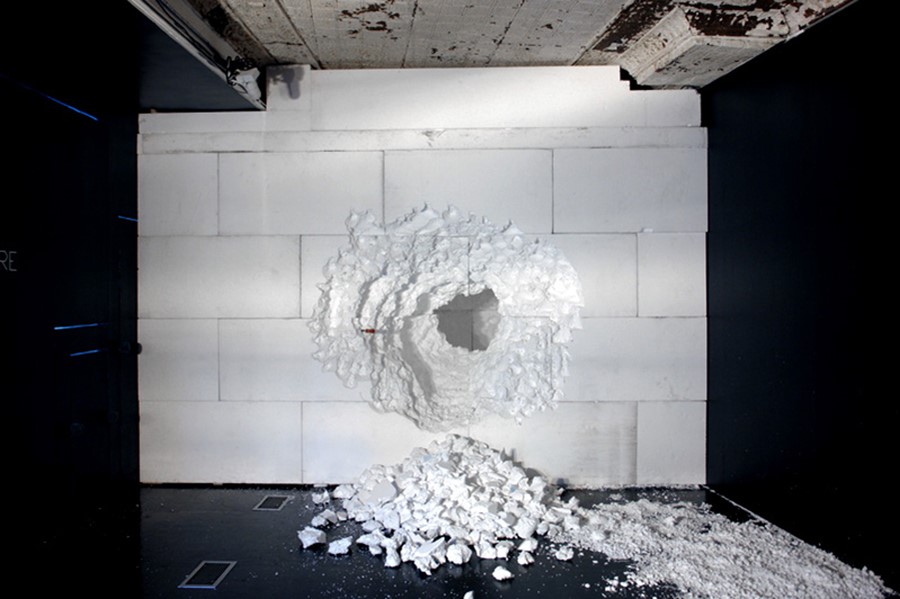Artist Daniel Arsham likes to say that he makes architecture do things that it’s not supposed to do. His exquisite works often blur the lines between art, architecture and performance, created through collaborations with Hedi Slimane, Merce
Artist Daniel Arsham likes to say that he makes architecture do things that it’s not supposed to do. His exquisite works often blur the lines between art, architecture and performance, created through collaborations with Hedi Slimane, Merce Cunningham and Robert Wilson. His current exhibition, DIG, currently installed at the Storefront for Art and Architecture in New York, is about excavation. AnOther recently caught up with Arsham, who was born in Cleveland, Ohio and who divides his time between Miami and New York. He had just landed in Atlanta, Georgia, where he was scheduled to perform a new performance piece called Replica the next night with the dancer Jonah Bokaer.
What is the concept behind the DIG exhibition?
A lot of my work from the past few years has involved eroding architecture. I started with these projects where a corner was eroded away in a 'fictional way'. Normally, if you smash a wall corner with a hammer, there would be studs and electrical wire and plumbing and everything else that is hidden within the architecture. The erosions imagine the architecture as a solid form so when they eroded there was actually a white form behind that, as if the wall was a solid entity. DIG essentially fills the entire gallery of Storefront For Art and Architecture with a solid form. Architecture is usually made by creating surfaces and planes that confine a volume. So you build a house. You build four walls and a roof and a floor and that defines an interior space but it’s always a process of addition where you’re adding things to define space. DIG is the opposite. It begins as a solid and the act of excavation, the removal of the form, creates this space within that. That’s the big explanation. The short version is that it’s kind of like a childhood fantasy to be digging through a 25 foot by 10 foot by 14 foot solid mass. I’ve been working on it this past week. It took about two and a half days before I could get into something and stand up inside that form. It’s a giant white cave.
What is it about architecture that appeals to you? How are you pushing its boundaries?
I don’t know if it’s something that appeals to me. It’s something that is a part of everyone’s life. But I’ve had a sort of strange encounter with it, with how it’s made, how it’s constructed and, in many ways, with how it can be pulled apart. I trace a lot of my interest in it back to a hurricane in Miami in 1992 that I was in. The house that I lived in at that time was completely destroyed while we were inside. Experiencing that and seeing what architecture is actually made out of and how it’s actually built was an experience – watching architecture explode and walls literally melt and erode and burst open with water and leaves and branches and wind. A lot of that has come into my work in abstract ways and, in general, in the way that this very severe natural force altered the architecture. I also alter architecture but in more playful and serene ways, perhaps, often making architecture do things that it’s not supposed to do.
Your architectural practice is called Snarkitecture. What is its mission?
A number of years ago, in 2005, I think, I was asked by Hedi Slimane to create an installation, a permanent installation in the new Dior boutique in Los Angeles. When he first approached me, the directions were very simple. The project ended up being more complex than I originally intended, precisely because it was one that engaged architecture in ways that were more affected by code. I was digging into the surface of a wall in order to place a mirror, recessed behind it, and I was cantilevering a very heavy bench off of a wall. In order to integrate this with the plan of the existing space that he had designed, I needed to work with an architect. I hired a friend, Alex Mustonen, to help me realise the project; it was easier to engage him with the skill sets that he had rather than trying to learn how to do it all myself. The project instigated a number of requests that were closer to architecture than my own art practice. We had this idea of forming an entity, which eventually became Snarkitecture. The name was inspired by a Lewis Carroll poem called The Hunting of the Snark, in which there is a group that’s hunting for a beast called the Snark. The have a blank map and have no idea what the beast looks like or where it is. Snarkitecture is a way for me to play around in larger spheres than I often have in my own practice.
What projects do you have in development at present?
For the next month I’m going to be inside a white cave, digging my way to the other side. I’m working on another project with Dior right now and also my last project with Merce Cunningham and will take place in a large venue in New York. After Merce passed away, he only wanted the company to last two years. It will be announced in the next month. A work I created with Snarkitecture and Johan Bokaer, which originally premiered in Rotterdam, in the Netherlands, and will have its US premiere at the Jacob’s Pillow dance festival in the Berkshire Mountains in August. The entire set is composed of 10,000 ping pong balls.
DIG runs until 23 April at Storefront for Art and Architecture, 97 Kenmare Street, New York.
Text by Ricky Lee
